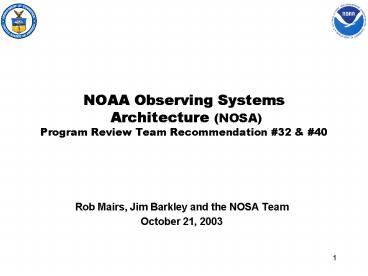NOAA Observing Systems Architecture NOSA Program Review Team Recommendation - PowerPoint PPT Presentation
1 / 16
Title:
NOAA Observing Systems Architecture NOSA Program Review Team Recommendation
Description:
Fixed. is. Space. Air. Ground. Ocean. Space. Air. Ground. Ocean. Basic Service Requirement drives ... Zoom in and select a footprint ... – PowerPoint PPT presentation
Number of Views:49
Avg rating:3.0/5.0
Title: NOAA Observing Systems Architecture NOSA Program Review Team Recommendation
1
NOAA Observing Systems Architecture (NOSA)
Program Review Team Recommendation 32 40
- Rob Mairs, Jim Barkley and the NOSA Team
- October 21, 2003
2
Initial Scope of Task Team
- Begin with systemic review of all NOAA observing
systems - Work closely with NOAA team developing the
requirements-based management process - Timeline for future observing system architecture
development TBD - Address only NOAA owned and/or operated systems,
but ensure expansion to international systems - Include operational and research systems
3
Methodology used for NOSA Baseline or as is
Architecture
- 1. Determine purpose of architecture effort
- 2. Diagram all relevant components of
architecture - 3. Determine what you need to know about each
component - 4. Build data collection methodology
- 5. Gather data
- 6. Publish and use
- 7. Establish method for maintaining
4
Enterprise Architecture Very short and short
definitions
- The explicit description and documentation of the
current and desired relationships among business
and management processes and supporting
infrastructure. - or
- An enterprise architecture is a tool to help
individuals think about their organization as a
whole. An enterprise architecture captures a wide
variety of information, establishes relationships
among the various documents and diagrams and
stores all of the information together in a
single repository, so that managers can then see
relationships, ask questions, identify problems,
or run simulations to help make decisions about
changes they are considering.
5
as-is NOAA Enterprise
BUSINESS PROCESSES
BUDGET
MANAGE
STAKE-HOLDERS
PARTNERS
IT INFRASTRUCTURE
HR
COMMS
USERS
SOFTWARE
STRATEGIC PLANNING
OBSERVING
FACILITIES
PROGRAMS
PEOPLE
SYSTEMS
PRODUCTS SERVICES
RESEARCH
PROJECTS
6
to-be NOAA Enterprise Architecture
STRATEGIC PLANNING
BUDGET
PROGRAMS
AP
MO
MANAGE
STAKE-HOLDERS
PRODUCTS SERVICES
BUSINESS PROCESSES
HR
UD
E,AI
PROJECTS
PARTNERS
OBSERVING
COMMS
FACILITIES
USERS
SOFTWARE
SYSTEMS
PEOPLE
IT INFRASTRUCTURE
RESEARCH
MO Monitor Observe
AP Assess Predict
UD Understand Describe
E,AI Engage, Advise Inform
7
Step 2. Observing System Architecture
Relationship Diagram
Observation Control System
is controlled by
Larger System
Owner
Support
provides data directly to
part of
supported by
owned by
Data Management System (CLASS)
Observing System
User
Operator
operated by
provides data to
provides info to
contains
is type of
Platform / Station
situated on
lt drives
located at
Stake-holder
Sensing Element
senses
Location
Environmental Parameter
is a
has
is
Stakeholder Requirement
characterizes
Human
Sensor
Mobile
Fixed
Environmental Phenomenon
Space
Space
Air
Air
Basic Service Requirement
Ground
Ground
lt drives
lt drives
Ocean
Ocean
8
Metis Architecture Modeling Tool
Objects Relationships
9
NOSA In the Big Picture
10
NOSA Target or to be Architecture Method
- 1. Assess observing systems effectiveness in
meeting NOAA strategic goals - 2. Prioritize observations or capabilities and
validate requirements - 3. Analyze alternatives to reach desired
effectiveness - 4. Select target that achieves most capability
within cost and other constraints
11
NOSA Geospatial Database
Maximizing utilization of NOSA data!
12
Internet Map Portal
Metadata and Station Data Links
13
Connecting Satellite and In-situ Observations
A
Satellite footprints in-situ observatories
C
Get a list of in-situ observatories that are in
the selected satellite footprint.
Zoom in and select a footprint
14
AVHRR and DMSP Footprints
POES (AVHRR)
DMSP
15
NOSA Significant Events
Integrating in-situ observatories with NESDIS
Operational Significant Event Image Geotiffs to
create a Map of the Day
16
NOSA Geospatial Partners?
NWS MIRS http//gisias.mirs.nws.noaa.gov/mirsweb/
index.cfm
NOS NowCoast http//nauticalcharts.noaa.gov/csdl/
op/nowcoast.htm































